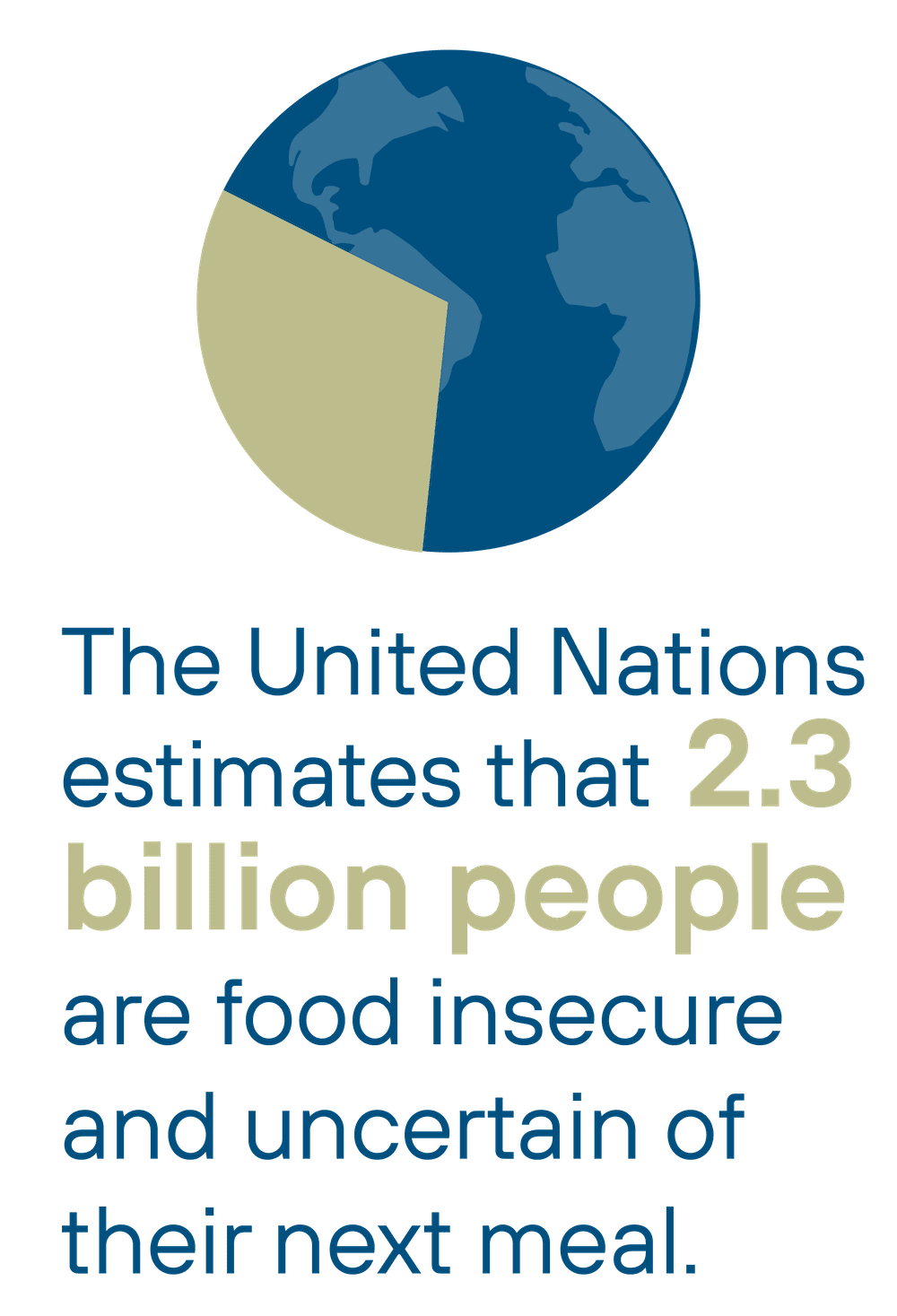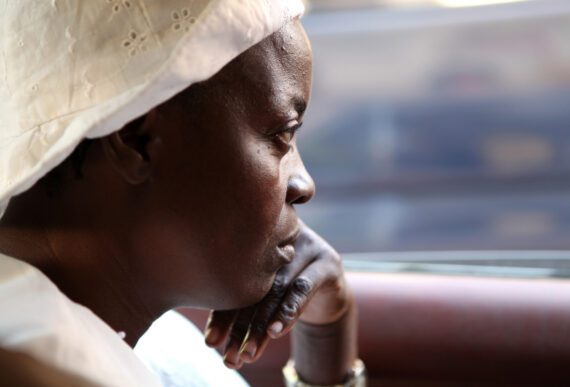Martin Luther King Jr. said, “Let us march on poverty until no American parent has to skip a meal so that their children may eat.” It’s been almost 60 years since he spoke those words and yet they are still timely.
Today, more than 40 million Americans struggle to put food on the table. And Black households in the U.S. experience food insecurity at three times the rate of white households.
King’s statements are part of a chorus of leaders and grassroots activists that have spoken up about hunger and poverty throughout time. From Marian Wright Edelman’s efforts to reduce child poverty to Ertharin Cousin’s work in the World Food Programme, there are many who have made strides to help end hunger.
Bread for the World continues to build upon those efforts. Moved by faith and God’s redemptive love, our organization has long advocated for Black freedom from hunger. We join the chorus of Black voices to help address racial inequities, food insecurity, and issues caused by climate change in Black communities in the U.S., Africa, and other parts of the world.
In acting out our mission, we underscore the need for effective food systems to address disproportionate hunger rates among Black populations. In this article, we will look at the state of hunger among Black populations, the role climate change plays, and how effective food systems can help reduce hunger.
The State of Hunger in Black Communities
What is the hunger rate among Black populations?
Hunger Rates in the United States
Black communities consistently face hunger at disproportionate rates. This is often due to historical discrimination, along with social, economic, and environmental challenges.
According to the U.S. Department of Agriculture, nearly 20 percent of Black households in the U.S. experienced food insecurity in 2021 — over three times the rate of white households.
Black children are also more likely to experience hunger than other children: While more than 1 in 5 U.S. children are at risk of hunger, the rate is 1 in 3 among Black children. In 2021, Black children were almost three times as likely to face hunger as white children, and 22 percent of Black children lived in food-insecure households.

Moreover, 2020 Census data shows the U.S. has an overall poverty rate of 11.4 percent, but within the Black community, the poverty rate is 19.5 percent. In other words, economic disparities are significantly high within Black communities and linked to food insecurity. It can be difficult to budget for enough nutritious food when living from paycheck to paycheck or underemployed.
Bread for the World’s 2023 state fact sheets give a local-level snapshot of poverty and hunger in the United States, and have highlighted once again that food insecurity exists throughout the country. What’s more, Feeding America’s most recent Map the Meal Gap research study included rates for several racial and ethnic groups. It found that disparities can vary significantly by population and place; and that while nearly 40 percent of the food insecure population in the U.S. is white, Black individuals are more likely to live in food insecure households.
Key takeaways:
- Black Americans overall are experiencing hunger at disproportionate rates.
- Black children in the U.S. are more likely to experience hunger than children of other backgrounds.
- Economic disparities are a major cause of food insecurity among the Black populations in the U.S.
Global Hunger Rates
Globally, more than one-third of people living with hunger live in Africa. The region has the highest prevalence of undernourishment, which is 21 percent of the continent’s population — more than double the rate in all other regions of the world. The World Economic Forum reports that “the main drivers of hunger [in Africa] include conflicts, climate change, and the COVID-19 pandemic.”
The situation in Somalia is particularly concerning, where near-famine levels of hunger are threatening millions. The country’s last famine, in 2011, led to the deaths of 260 million people, half of whom were children under 5.
People in Somalia have endured decades of political instability and violence due to armed conflict, leading to alarming levels of life-threatening hunger and malnutrition. The problem has been exacerbated in recent years by climate changes that have caused damage to the local environment and economy.

Hunger rates in several other African countries are considered to be at an emergency level by the World Food Programme, including in Burkina Faso, Madagascar, Mali, Nigeria, Niger, South Sudan, Ethiopia, and the Democratic Republic of Congo. Conflicts, climate change, and economic inequality have slowed progress on reducing hunger in these nations. For example, more frequent severe weather and droughts have hurt farmers’ ability to produce enough food.
Additionally, many people experiencing poverty and hunger in sub-Saharan Africa live in rural areas and make their livelihoods off the land. Decades of underdevelopment and underinvestment in agricultural infrastructure have impeded their farming capabilities as well.
Key takeaways:
- People throughout Africa are experiencing hunger at disproportionate rates.
- The main drivers of hunger in Africa include conflicts, climate change, and the COVID-19 pandemic.
- Near-famine levels of hunger are threatening millions in Somalia;
- Hunger rates in several other African countries are considered at an emergency level, including in Burkina Faso, Madagascar, Mali, Nigeria, Niger, South Sudan, and Ethiopia
The Impact of Climate Change
What impact does climate change have on Black communities?
Climate change is the greatest environmental challenge the world has ever faced. It is damaging crops, threatening water security and safety, and disrupting access to food for millions. This is especially true for Black communities and other populations that are disproportionately impacted by hunger.
Impact of Climate Change in Africa
The African continent is at an exceptionally high risk of the consequences of climate change, despite only producing about 3.8 percent of annual global CO2 emissions. And as soon as the 2030s, climates and weather trends in many African countries are expected to be impacted.
The negative results of climate change are already being felt by farmers who grow food in Kenya and across the continent. Climate-related disasters, like flooding and drought, have devastated food supplies and critical infrastructure. This has repeatedly caused disastrous effects on the most vulnerable communities.
Recognizing the need to address climate change and its impact on people experiencing hunger in Africa and worldwide, Bread for the World hosted a Convocation on Climate Change and Hunger in Nairobi, Kenya, in October 2022.
The two-day event was organized ahead of the Conference of the Parties to the United Nations Framework Convention on Climate Change (COP27). We brought together close to 70 Christian faith leaders from Africa, Europe, and the U.S. to discuss the ways climate change is exacerbating global hunger and to sign a faith statement outlining our commitment to take action.
Strikingly, in Kenya alone, 3.5 million people need humanitarian assistance, and 360,000 Kenyans are on the verge of famine. In the nation’s largest county, Marsabit, “20 percent of the population is suffering from life-threatening hunger and malnutrition.” The Red Cross estimated in 2022 that around 755,000 Kenyan children under age 5 are acutely malnourished.
Still, there is progress being made and ample opportunity for more positive change. Smallholder farmers and others in Kenya are leveraging their resources to reduce the impact of climate change, strengthen local infrastructure, and lower national hunger rates. We can all play a role by calling on the U.S. government to assist such efforts in Kenya and other African nations through direct aid and support.
Impact of Climate Change on Black Communities in the U.S.
Climate change is negatively impacting Black communities in the United States as well.
According to the American Public Health Association, communities of color are more likely to experience poor living conditions. This has been attributed to historical discrimination and a lack of economic resources, and often leaves Black communities vulnerable to severe weather.
Notably, 54 percent of Black Americans live in southern states, a region of the U.S. that is expected to see increased flooding and hurricanes due to climate change. What’s more, historical housing biases have led many African Americans to live in less desirable, flood-prone areas and neighborhoods with poor access to quality, affordable food — also known as “food deserts” — in cities throughout the U.S.
Black Americans also tend to live in neighborhoods that are close to power plants, chemical plants, and factories. These facilities are often unprepared or ill-equipped to deal with strong storms, and storms can result in the release of toxic pollution. For example, after Hurricane Harvey – which hit parts of Texas and Louisiana in 2017 – local petrochemical plants released cancer-causing benzene at alarmingly high rates.
Adding to such issues is a lack of economic and political leverage that could aid in building climate resilience, or the ability to prepare and respond to extreme weather events caused by climate change.
The unfortunate consequences of this were apparent during 2005’s Hurricane Katrina: many Black residents of New Orleans were forced to leave their homes, and more than half of those who perished in the hurricane were Black.
Research has even shown that U.S. neighborhoods historically shaped by discriminatory “redlining” housing policies tend to have “lower than average vegetation cover,” thus residents are at greater risk of being exposed to extreme heat.
All of these factors can contribute to disruptions in quality of life, access to nutritious food, and contamination of water supplies, all of which exacerbate hunger and food insecurity in Black communities across the U.S. Yet, there is hope in today’s myriad of activists and voices who are advocating for climate justice and an end to hunger and poverty. With our collective will and advocacy, we can see progress on climate issues that impact hunger rates—not only among Black communities in the U.S. but among people around the world.
The Need for Effective Food Systems
How can effective food systems help end hunger in Black communities?
Effective food systems are key to ensuring all people have access to enough nutritious food, especially in Black communities.
The term “food system” typically refers to the steps and methods within the food supply chain — from the production of crops, livestock, fish, and other food commodities to the transportation, processing, preparation, and retailing of foods. It also involves the policies and cultural norms around food.
An effective approach would be to first consider how historical inequities have left Black populations and other groups disproportionately impacted by hunger. Through this lens, we can work to establish solutions for food access that meet the needs of all.
Thankfully, there is work being done toward this objective at both the grassroots and political level. Black voices have been present alongside numerous activists, churches, and organizations in efforts to end hunger, building on a legacy of advocacy among leaders of all backgrounds. And today, our collective call for effective food systems holds the promise of ensuring a brighter, more equitable future.
A Vision for Effective Food Systems
Ideal food systems would be centered on sustainability, access, nutrition, safety, affordability, and efficiency. To realize this vision, we must urge our leaders to enact legislation and policies that move our nation and the world toward sustainable and equitable food systems. We also need continued investments in agricultural research and technological innovations that can further pave the way toward this goal.
For instance, in the U.S., soil degradation is a serious problem often caused by widespread use of artificial fertilizers. Another big issue is increasing emissions of nitrous oxide, one of the greenhouse gases that contribute to climate change. By funding research on sustainable alternatives, we can prevent further damage to fertile soil and the environment.

Bread for the World believes that every human being is created in the image of God and has the right to proper nourishment. We have worked alongside Black farmers to transform our nation’s food systems in sustainable ways. Our organization also advocates for effective structures and policies that “affirm equality and advance equity to alleviate hunger and poverty.”
These structures include the agriculture, activities, and resources necessary to bring food from its source to people’s tables. It is essential that systems around farming, processing, and preparing food function to protect those disproportionately impacted by hunger. As such, we’re calling for reauthorization and expansion of the Farm Bill.
The Importance of the Farm Bill
“Farm bill” refers to legislation that impacts many parts of the U.S. food system. In fact, nearly three-fourths of the bill’s funding goes to nutrition programs, particularly the Supplemental Nutrition Assistance Program (SNAP). In 2021, SNAP helped more than 40 million Americans put food on the table.
This year, the Farm Bill is due to be reauthorized for an additional five years, and Congress has an opportunity to improve food security and agriculture across the country.

The United Nations estimates that 2.3 billion people — over a quarter of the world’s population — are food insecure and uncertain of their next meal. Therefore agricultural research is critical to ensuring farmers have the right tools to grow nutritious food sustainably, and investment in the research title of the Farm Bill is a Bread priority.
Bread for the World’s Advocacy
In 2022, Bread held 29 regional Farm Bill listening sessions with 730 grassroots advocates and over 100 meetings with farmers, local food system leaders, members of Historically Black Colleges and Universities, and U.S. Department of Agriculture officials.
Our goal was to build and strengthen relationships and learn what they are planning to advocate for in the 2023 Farm Bill. As a result, we stand alongside our partners in seeking to:
- improve nutrition in the U.S. by increasing access to healthy food;
- foster equity by expanding access to SNAP among marginalized populations; and
- address the threats to food security posed by climate change
This Black History Month and beyond, let’s reflect on the disproportionate rates of hunger among Black populations globally and commit to being part of positive change.
In doing so, we can all seek to learn more about effective food systems and urge our nation’s leaders to expand and reauthorize the Farm Bill, which has significant domestic and international implications. Writing and emailing members of Congress, for example, can be an impactful way to push for solutions that help address historical racial inequities. Hunger is solvable in our time. There is hope in the present and an attainable vision for a future where all people have access to nutritious food. As individuals, congregations, and organizations, we have a special opportunity to take action toward this goal.



